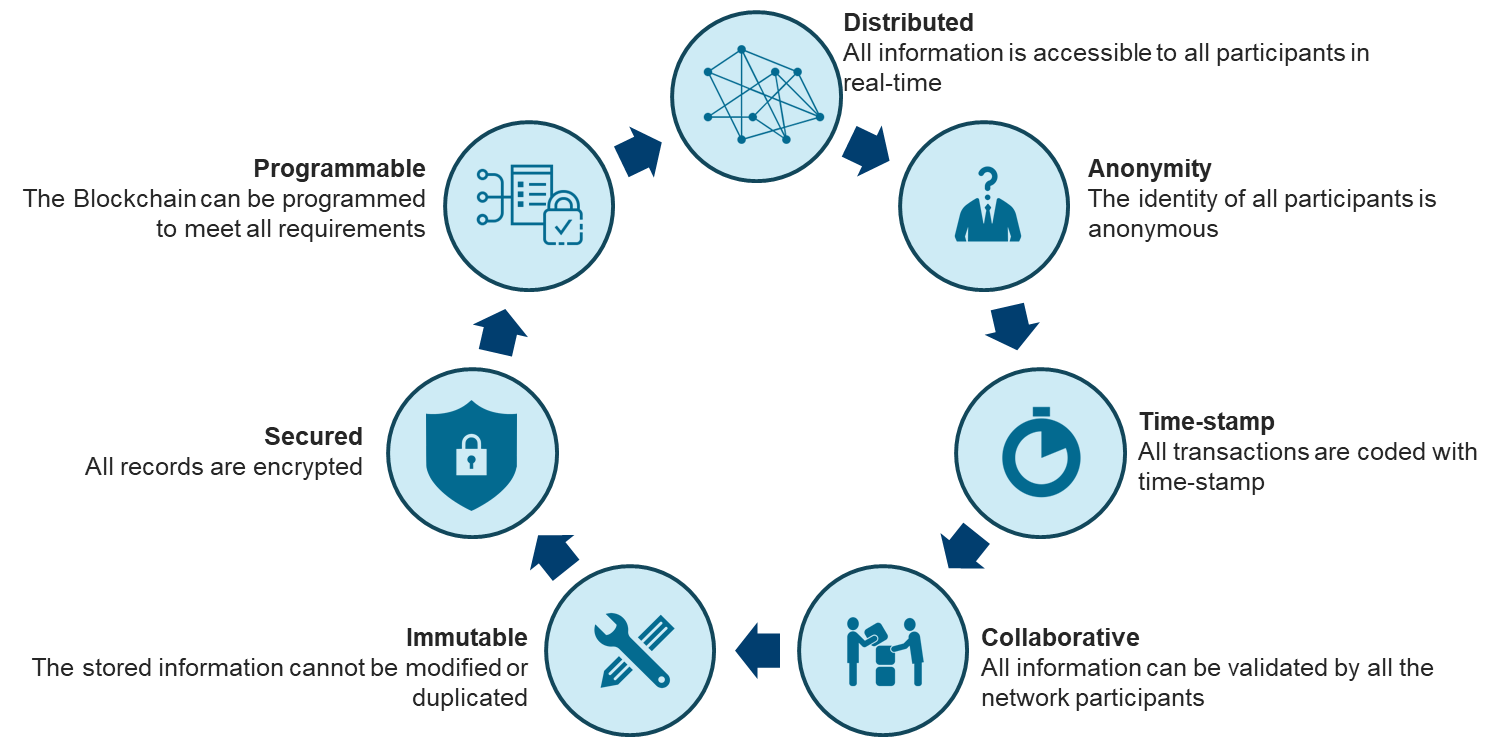Five Benefits Insurers Can Reap From Blockchain
Published on 01 Sep, 2020

Till date, the insurance sector has been weighed down by conventional, outdated, and labor-intensive operating models. However, as the industry progresses with the recent technological advancements, innovative Blockchain-based solutions could provide opportunities for insurance companies to expand as well as increase profitability. Blockchain could be the solution to various challenges encountered by global insurers.
Insurance providers have followed the conventional human-centric business model that concentrates on customers, agents, brokers, underwriters, adjusters (investigates and settles claims), and re-insurers. However, technological advancements such as data analytics, business intelligence, cloud computing, and Blockchain could lead to the evolution of the sector. Most of these technologies have steadily penetrated the insurance sector, except Blockchain, which lingers in the proof-of-concept stage. Several elements such as low awareness, perceived views on security, or limited understanding of the concept itself have hindered the adoption of the technology across insurance businesses.
Blockchain is defined as a combination of a Block (form of digital information) and a Chain (public database), i.e., a piece of digital information saved on a public yet secured database. Key features of Blockchain technology are described below:

The insurance sector continues to be restricted by longstanding challenges that have hindered the growth and lowered the profitability of insurers. Blockchain presents numerous advantages and business-use for insurers across all product lines – life, auto, marine, property, health, and other non-life insurance.
Managing operating costs
Insurance companies always struggle to manage business operating costs ascribed to massive amounts of paperwork, manual intervention, and additional regulatory compliance, such as Know Your Customer (KYC) and Anti Money Laundering (AML). Despite heavy investments, insurers’ operating capacities can get stretched in case of natural disasters or pandemics such as the COVID-19 outbreak. Blockchain allows insurers to build efficiencies across multiple business operations of selling, re-selling, and managing insurance policies, thereby achieving a reduction in operational costs.
- Blockchain-based Smart Contracts are executed automatically if the underlying conditions are met, allowing insurers to save time and cost of processing the claim. It also safeguards policyholders from the trouble of filling numerous claim forms.
For instance, smart contracts are executed automatically on flight delays, and the claims are processed post auto-validation of the information received from public databases, all of which are encrypted. - Blockchain assists in removing duplication of effort. Policyholders usually engage with multiple insurers that perform the same tasks (KYC/AML), leading to duplication of work and client records. With Blockchain, insurers can collate resources to build a central repository that is economical and secured to store and access client information.
Reducing processing time
Long processing time for purchasing a policy or getting claims reimbursed can be frustrating. Purchasing a policy entails a lot of paperwork, creating a tiring, long-winded process that worsens when policyholders put in their claims. Despite insurers maintaining a team of adjusters (individuals who validate and process the claims), the long processing time prevails. Claim processing requires an exchange of information and documentation that extends the timeline. For instance, in case of a road accident, the insurer must verify policy details, inspect the vehicle, and obtain information from the other insurance company and healthcare facilities. The integrated and centralized repository of Blockchain offers several benefits:
- Central repository provides easy access to information for quick validation by all parties.
- Insurers can avoid duplication of manual work on building records.
- It allows providers to reduce the time lost in exchanging information.
- Encryption aids in sharing sensitive information (e.g., health records and financial information).
- It provides fast and transparent means to process claims.
- It lowers operating costs, which can translate to reduced premium.
- It boosts customer experience through quick turnaround at low costs.
Maintaining data privacy
Insurers collect large amounts of sensitive data from policyholders (e.g., health records, financial information, and personal details), which can be used for unlawful activities. Consequently, the loss of data can have serious implications on the insurers. Also, litigation and compliance costs could potentially leave a severe dent on the financial stability of insurance providers. Hence, a secured way of storing and sharing information is essential.
For instance, health records are incomplete, reproduced, and outdated as policyholders consult various health professionals and visit multiple health facilities. Thus, insurers need to liaison with all stakeholders and personally collate information, which is time consuming and bumps the operating costs. The secured, encrypted, immutable, and centralized nature of Blockchain helps in meeting compliance and data privacy requirements that have hampered the development of the sector.
Detecting fraud
Insurance providers, a goldmine of sensitive personal and financial information, are prime targets to fraudsters that hit “blind spots”, which are difficult to identify using data sets of few insurance providers. Also, the competitive setup limits the sharing of information of these unlawful activities in the community. Currently, fraud detection is largely based on information available publicly or collated by private agencies, which is often incomplete.
|
“Non-health insurance fraud in the US is estimated to be over USD 40 billion per year, which can translate into $400–700 per year in extra premiums” – Federal Bureau of Investigation |
Blockchain allows users to collate claim-related and other information from multiple insurers, providing a larger dataset to identify patterns. Additionally, cryptographic data can be shared easily by insurance providers without divulging personal information of the policyholder. Furthermore, being anonymous, these fraudulent activities can easily be discussed for the benefit of the insurance community. Few common fraudulent activities in the insurance sector include:
- Duplicating processing of claims
- Manipulating ownership of an insurance policy
- Insurance products sold by unlicensed brokers
Improving customer experience
High operating costs, long processing timelines, frauds, and data breaches often impact policyholders in the form of high premiums and losses arising from identity thefts. The insurance industry is highly competitive, and insurers need to add considerable impetus on customer experience. Customer satisfaction and loyalty are largely driven by quality of aftersales service, claims processing turnaround, and most importantly, effective management, sharing, and interpretation of data.
In a nutshell, Blockchain can resolve majority of these challenges and create a win-win situation.
- Insurers benefit from reduced costs, loyal customers, repeat businesses, and improved profitability.
- Policyholders enjoy speedy claims processing, reduction in claim denials, data privacy, restricted fraudulent activities, and possibly, even reduced premiums.
Blockchain-based solutions
The insurance sector witnessed a rise in multiple proof-of-concept stage offerings that could potentially disrupt the market, including:
Company Name |
Blockchain Offering |
|---|---|
R3 | R3, an ecosystem of ~300 firms, builds Blockchain-based apps on the Corda platform, allowing insurers to securely automate back office operations and streamline claims management, data processing, underwriting, and information sharing. |
B3i | B3i, a consortium of Swiss Re, AXA, Zurich, Munich Re, and Allianz, offers Blockchain-based applications to streamline claims management and lower costs and processing time. In July 2019, it launched Catastrophe Excess of Loss, a product on Corda, allowing brokers, insurers, and reinsurers to efficiently manage risks and remove repetitive manual activities. |
Insurwave | Insurwave, a marine hull insurance platform launched in 2018, was developed in partnership with Ernst & Young, Guardtime, Maersk, Microsoft, and ACORD. The platform, built on R3’s Corda platform, offers real-time information on ships’ location, condition, and safety to both insurers and customers, and allows insurers to swiftly underwrite and price policies based on an immutable audit trail of ship movements. The commercialized platform is projected to manage risks of over 1,000 commercial vessels and automate over 500,000 transactions in its first year of operation. |
Etherisc | Etherisc’s Blockchain-enabled smart contracts commenced testing in 2017. It is a cryptocurrency-based flight delay program allowing travelers to purchase flight insurance through cryptocurrency or fiat currency and receive pay-outs automatically. The company’s other products in the proof-of-concept stage include hurricane insurance, crypto wallet insurance, and crop insurance. |
MedRec | MedRec is a decentralized content management system for medical records developed by MIT that indexes medical records on Blockchain, thereby enabling permitted audience to easily access information along with patient privacy and audit trail. |
Ryskex | Ryskex, a German InsurTech founded in 2018, provides a Blockchain-based insurance platform to B2B insurers to swiftly transfer risks and be transparent. |
Fizzy (AXA) | Fizzy is a Blockchain platform launched by AXA in 2017; it provides flight delay smart contracts. Fizzy was discontinued in 2019 due to limited traction from travelers and airline carriers. |
Some insurers have already deployed Blockchain to execute various processes and operations, which could provide support for the wider adoption of the technology across the value chain.
Company Name |
Blockchain Offering |
|---|---|
Blue Cross | The Hong Kong-based insurer started using Blockchain in April 2019 to rapidly process medical insurance claims and prevent fraud. The platform allows insurers to validate claims data, reduce fraud potential from duplicate claims filing, and reconcile claims data from insurers and medical service providers. Blue Cross’ Blockchain platform is built on Hyperledger. |
Tokio Marine | The Japanese property and casualty insurer uses blockchain to validate marine cargo insurance certificates. Till date, it reported 85% decline in processing time. |
Allianz | Allianz uses smart contracts to expedite the contract management process for bonds and cat swaps that are used for transferring specific risks, typically natural disaster risks, to investors from an insurer. |
Lemonade | Lemonade uses Blockchain and Artificial Intelligence to offer insurance products to renters and homeowners using smart contracts. |
Teambrella | The Russian company operates a centralized insurance platform that co-insures the claims. It uses smart contracts to execute insurance payments. The company currently has 4 groups dealing with bicycle damage and pet injuries in Peru, Argentina, Germany, and the Netherlands. |
In a nutshell, Blockchain could open a pandora’s box for the insurance sector and provide an opportunity to do away with conventional business models and improve customer experience and profitability. Additionally, with the tech-savvy future generation being dominated by the use smart devices and terabytes of data, Blockchain could revolutionize the insurance industry. However, we expect certain challenges, such as capital investment and lack of awareness, to hinder the adoption rate. In the long run, Blockchain would become an integral part of the insurance business as insurers strive to optimize costs and boost profitability.
